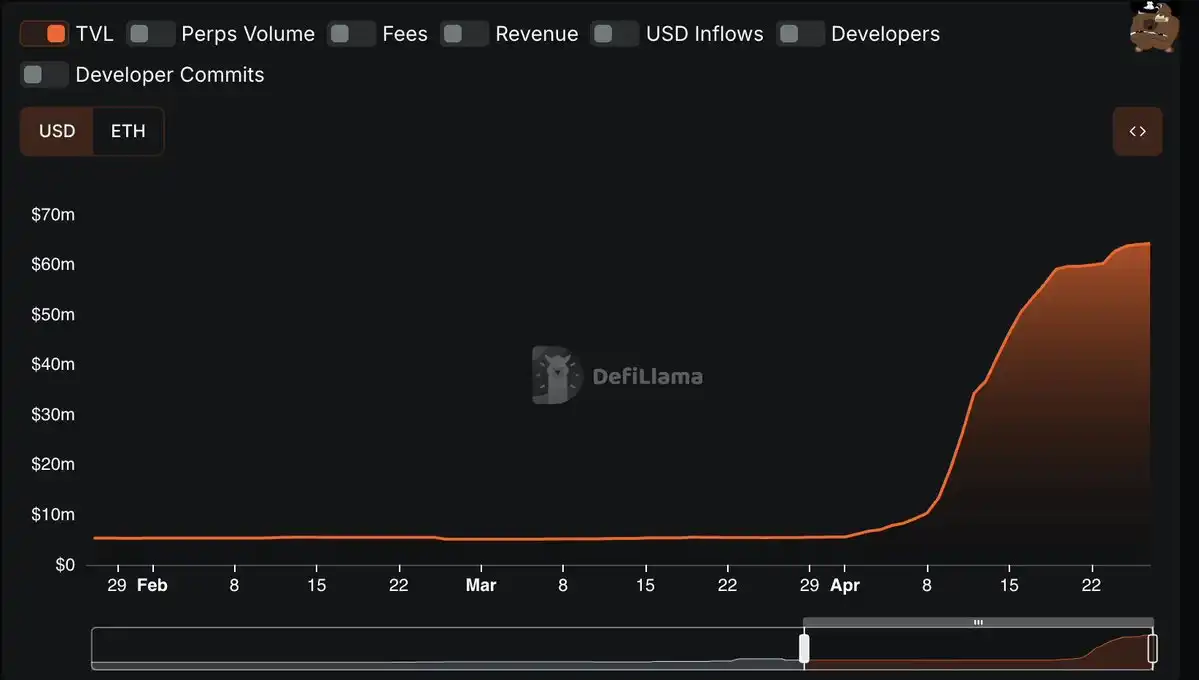Original Title: The Genesis Story: How Crypto Found Me
Original Author: @hmalviya9
Original Translation: zhouzhou, BlockBeats
Editor's Note: Currently, while the usage of RWA perpetual products (such as Ostium) has surged, the GLP-style liquidity model is unsustainable due to high funding rates, zero-sum games between traders and LPs, and a lack of hedging mechanisms, which limits platform expansion. In contrast, HyperLiquid's more flexible HLP model performs better. In the future, if Ostium shifts to an order book model, reduces fees, and enhances market efficiency, it may achieve long-term healthy development.
The following is the original content (reorganized for better readability):
In the past month, as the tariff crisis looms, the currency market fluctuates, and the stock market moves like an electrocardiogram, the usage of RWA perpetual contracts has seen astonishing growth. The total deposits on @OstiumLabs skyrocketed from a stable under $6 million to over $60 million in just one month. Trading volume has also increased significantly. HyperLiquid has also launched the PAXG perpetual contract market from @Paxos.
The demand for using crypto derivatives to long or short RWA has become very clear. The question is, are the current solutions good enough? If not, how can they be improved?

Why might these solutions not be good?
In the beginning, I mentioned two seemingly contradictory points: on one hand, traders are indeed using RWA products; on the other hand, I question whether the existing solutions are good enough.
Some might think that since users are choosing these platforms, it indicates that the current RWA perpetual contracts are good enough. But that's not the case; let me explain with some data.
If we look at the funding rates on Ostium, we can see that the funding rate for the gold trading pair (XAU/USD) was as high as 30% and is currently still at 13%.
In contrast, the current funding rate for BTC on Bybit is about half of that on Ostium, while the funding rates for BTC on Binance and OKX are only about a quarter of Ostium's. Some might think this is because gold is performing better, but that's not necessarily true.
Gold has risen about 50% this year, while Bitcoin's increase is roughly similar.
Moreover, when we compare the crypto market with traditional financial markets (like CME), the gap becomes even more apparent. If you go long on gold in CME and roll your position, the annualized cost is about 6%, which is only half of Ostium's lowest funding rate, a difference of 600 basis points.
Seeing such a large price difference, readers engaged in delta neutral trading might feel there is a huge arbitrage opportunity: for example, shorting on Ostium to collect a 13% funding rate while going long on CME at a 6% annualized cost. But that's not the case.
Because Ostium uses a GLP-like model (similar to GMX's liquidity pool), if you short on Ostium, you actually have to pay a 13% funding rate.
This leads to a lack of incentive for both delta neutral traders and market makers to provide liquidity. This is not a coincidence but a fundamental issue in Ostium's design.

The Unsustainability of the GLP Model
The GLP model used by Ostium and @GainsNetwork_io is, in simple terms, not scalable.
The GLP model essentially has all traders betting against the protocol's liquidity pool. It was first introduced by GMX, whose liquidity pool is called GLP. At Ostium, it is called OLP; at Gains, it consists of various g(asset) vaults.
It is important to note that the GLP/OLP model is very different from @HyperliquidX's HLP model. The pricing model of HLP is hidden and dynamically changing, while the pricing of GLP is fixed and static.
This means that although HyperLiquid also has base liquidity providers, the base LP is not the only counterparty, and the funding rate mechanism can continue to incentivize the market towards greater efficiency. In Ostium's OLP model, traders must incur losses for OLP's liquidity providers to make a profit. This is a complete zero-sum game.
Moreover, unlike the HLP model, which can partially hedge exposure on-chain, the OLP model lacks a stable mechanism to hedge RWA risk exposure.
While the OLP model helped Ostium quickly ramp up liquidity in its early stages, it has now become an obstacle to their continued growth. Just as HyperLiquid ultimately had to relinquish absolute counterparty control over user trading in HLP, Ostium will also need to loosen OLP's dominance over pricing to achieve greater scalability.
A cautionary case has already emerged: in terms of relative market share in the gold market, Ostium currently has a position size of only $4 million, while HyperLiquid's newly opened PAXG market has reached $15 million (with lower funding rates and opening costs).
Additionally, Ostium's current total locked amount is $65 million, of which $57 million, or 86% of the funds, are concentrated in OLP. In contrast, while HyperLiquid's figures are also high, the proportion is around 60%, which is comparatively healthier.
In summary, this model is unsustainable.
Possible Directions for the Future
Although the aforementioned issues could be serious if left unaddressed, theoretically, they can all be resolved by changing the model.
If Ostium can shift to an order book model, it can reduce transaction fees, and funding rates will decrease due to improved market efficiency, while the platform can still profit from transaction fees.
OLP can continue to exist but should operate in a more dynamic and flexible manner.
In my personal view, as someone who loves the RWA perpetual concept, this is the only sustainable long-term model for RWA perpetual products, not just for Ostium, but for Gains and all related projects as well.
The GLP/"casino-style" model can only be used in the cold start phase; it is unrealistic for long-term development, and this has been validated multiple times.
免责声明:本文章仅代表作者个人观点,不代表本平台的立场和观点。本文章仅供信息分享,不构成对任何人的任何投资建议。用户与作者之间的任何争议,与本平台无关。如网页中刊载的文章或图片涉及侵权,请提供相关的权利证明和身份证明发送邮件到support@aicoin.com,本平台相关工作人员将会进行核查。




